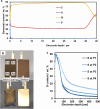Thickness Variation of Conductive Polymer Coatings on Si Anodes for the Improved Cycling Stability in Full Pouch Cells
- PMID: 38747165
- PMCID: PMC11145580
- DOI: 10.1021/acsami.3c17597
Thickness Variation of Conductive Polymer Coatings on Si Anodes for the Improved Cycling Stability in Full Pouch Cells
Abstract
Si-dominant anodes for Li-ion batteries provide very high gravimetric and volumetric capacity but suffer from low cycling stability due to an unstable solid electrolyte interphase (SEI). In this work, we improved the cycling performance of Si/NCM pouch cells by coating the Si anodes with the conductive polymer poly(3,4-ethylenedioxythiophene) (PEDOT) prior to cell assembly via an electropolymerization process. The thicknesses of the PEDOT coatings could be adjusted by a facile process parameter variation. Glow-discharge optical emission spectroscopy was used to determine the coating thicknesses on the electrodes prior to the cell assembly. During electrochemical testing, improvements were observed closely linked to the PEDOT coating thickness. Specifically, thinner PEDOT coatings exhibited a higher capacity retention and lower internal resistance in the corresponding pouch cells. For the thinnest coatings, the cell lifetime was 18% higher compared to that of uncoated Si anodes. Postmortem analyses via X-ray photoelectron spectroscopy and cross-sectional scanning electron microscopy revealed a better-maintained microstructure and a chemically different SEI for the PEDOT-coated anodes.
Keywords: PEDOT; conducting polymers; lithium-ion battery; silicon anodes; solid electrolyte interphase.
Conflict of interest statement
The authors declare no competing financial interest.
Figures





References
-
- Chae S.; Choi S.-H.; Kim N.; Sung J.; Cho J. Graphit- und-Silicium-Anoden für Lithiumionen-Hochenergiebatterien. Angew. Chem. 2020, 132 (1), 112–138. 10.1002/ange.201902085. - DOI
-
- Cano Z. P.; Banham D.; Ye S.; Hintennach A.; Lu J.; Fowler M.; Chen Z. Batteries and Fuel Cells for Emerging Electric Vehicle Markets. Nat. Energy 2018, 3 (4), 279–289. 10.1038/s41560-018-0108-1. - DOI
-
- Lithium-Ion Batteries; Materials Research Foundations; Materials Research Forum LLC, 2020.
-
- Armand M.; Axmann P.; Bresser D.; Copley M.; Edström K.; Ekberg C.; Guyomard D.; Lestriez B.; Novák P.; Petranikova M.; Porcher W.; Trabesinger S.; Wohlfahrt-Mehrens M.; Zhang H. Lithium-ion batteries – Current State of the Art and Anticipated Developments. J. Power Sources 2020, 479, 22870810.1016/j.jpowsour.2020.228708. - DOI
-
- Asenbauer J.; Eisenmann T.; Kuenzel M.; Kazzazi A.; Chen Z.; Bresser D. The Success Story of Graphite as a Lithium-Ion Anode Material – Fundamentals, Remaining Challenges, and Recent Developments including Silicon (Oxide) Composites. Sustainable Energy Fuels 2020, 4 (11), 5387–5416. 10.1039/D0SE00175A. - DOI
LinkOut - more resources
Full Text Sources

